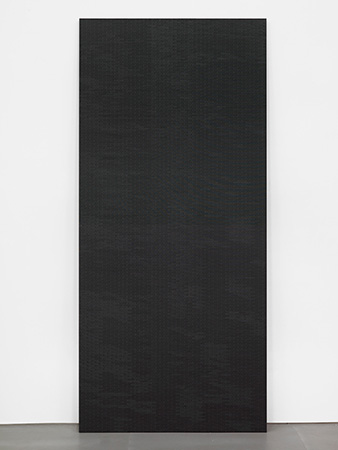1 May–6 June 2015
Opening: Friday, 1 May, 6–9pm
carlier | gebauer
Markgrafenstraße 67
10969 Berlin
Germany
www.carliergebauer.com
Facebook / Instagram
carlier | gebauer is very pleased to present Filipino artist Maria Taniguchi‘s first solo exhibition with the gallery, opening 1 May from 6 to 9pm. Featured works include the latest black and grey brickwork paintings from the larger project Untitled (2008–ongoing) comprising nearly 30 pieces to date of similar technique and format. Other works include a sculptural stack of paper posters depicting the dark entryway to an ancient cave dwelling, and a number of geometric shapes that resonate with the structural elements and building blocks of Taniguchi’s signature paintings.
These dark, imposing and methodical paintings of interlaced brickwork shall tightly line the gallery walls as one continuous work in a graph diagram. Beginning with a monochrome grey background, Taniguchi maps out a network of small graphite lines mimicking the designs used in bricklaying. Then, using varying densities of black acrylic paint, each “brick” is meticulously filled in—allowing for slight aberrations to be revealed in the formal patterning as light reflects across the smooth surface. Her work deals with the progression of time in relation to the accumulation of form and experience in artistic production. The repetition and modulation of individual markings read like a coded speech locked in persistent conversation. It is a conversation seemingly closed in, but in fact is open to present interruptions and future engagements.
Taniguchi’s large format, wall-like paintings also take on dimensions that are decidedly sculptural and architectural as they are stretched on aluminum frames and set on the floor to gently lean against the gallery walls. The aesthetic of an exterior surface is brought into the interior as a phantom shadow of a built environment.
Following a lineage of artists dealing with time-based patterning such as On Kawara, who focused on the singularity of unique historical moments in time, or Channa Horwitz, who categorically charted movement over time, Maria Taniguchi maps the process of self-awareness through an understanding of the continuity of time.
In parallel, large-format photographic works by Irish artist Richard Mosse and new sculptures by German artist Asta Gröting will be exhibited in the gallery for the first time.
Richard Mosse has developed a body of photographic and filmic work that is both unabashedly aesthetic and fraught with political and ethical implications. Mosse´s portraits and landscapes shot in the conflict-stricken eastern Democratic Republic of Congo probe entrenched views on photographic representations of crises and the ethical and political responsibilities to which they lay claim. His photographs use Kodak Aerochrome, a discontinued color infrared aerial surveillance film. Originally developed for military reconnaissance, this film registers an invisible spectrum of infrared light, rendering the green landscape in vivid hues of lavender, crimson and hot pink. The results offer a fevered inflation of the traditional reportage document, underlining the growing tension between art, fiction, and photojournalism.
The new work by Asta Gröting, When My Mother Was Dying (2015), is a continuation of the series “Space Between a Family,” which are casts of the artist’s family, and “Space Between Lovers,” which is a cast of a couple having sex. These works reflect upon the unseen and unknowable space in between form and experience.
“Freud told us that civic monuments and memorials are made to preserve the memory of a traumatic event (war, the loss of human life) and invite us to remember the painful experiences of the past. Gröting continues this conversation by sculpting monuments that preserve the memory of the present, or which ask questions of the present, while inviting us to speculate on a timeless absence—something or someone lost, missing, gone. If it is a celebration and conservation of life, it is also an unsentimental gaze at family relations—the empty but haunted space of all that is unspoken between them. It is not hard to imagine that these introspective figures possess internal organs, (lungs, hearts, kidneys) but they are uncanny too, mournful grey ghosts of substance who seem to be emerging from both a war and a womb.”
–Deborah Levy
